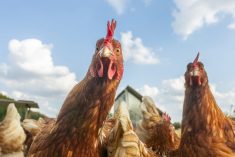Canada and the United States have agreed to maintain livestock and meat trade during animal disease outbreaks using a new system that targets trade bans more precisely by region, federal Agriculture Minister Gerry Ritz said Wednesday.
In 2003, the U.S. and many other countries halted beef imports from Canada after the discovery of bovine spongiform encephalopathy (BSE) on an Alberta farm. The trade bans caused prices for Canadian cattle to collapse, resulting in severe financial losses for ranchers.
Under the new system — which won’t take effect until after consultation with industry groups and details are worked out — each country would only restrict trade within designated disease-control zones where the animal disease breaks out.
Read Also

U.S. livestock: Cattle strength continues
Cattle futures on the Chicago Mercantile Exchange were stronger on Friday, hitting fresh highs to end the week.
If such a system had been in place in 2003, the U.S. would likely only have restricted imports of beef from Western Canada, not the entire country, Ritz said at a press conference in Winnipeg.
"The new agreement will help prevent or limit the introduction of highly contagious foreign animal diseases from one country to the other," he said. "At the same time, this agreement will help avoid unnecessary trade disruptions.
"This is a sensible approach."
In practice, under this arrangement, if Canada’s government were to set up a disease control and eradication zone anywhere within Canada, the U.S. Department of Agriculture would continue to allow imports of live animals, animal products and byproducts from disease-free areas of Canada.
Once Canada released the zone, the U.S. would allow trade to resume from that area.
"Reciprocal arrangements" would apply in the case of zones established anywhere in the U.S., the federal government said.
Along with BSE, other animal diseases with potential to disrupt trade include foot-and-mouth disease, H1N1 flu and avian influenza.
The U.S. is the biggest market by far for Canadian exports of cattle, pigs, beef and pork.
The system comes out of a U.S.-Canada agreement in December 2011 to align regulatory systems in order to increase efficiency, reduce manufacturing and retail costs, and boost North American trade.
— Rod Nickel is a Reuters correspondent in Winnipeg.



















